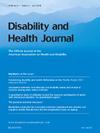Daily physical activity and cardiorespiratory fitness in adults with Down syndrome with and without congenital heart disease
IF 3.3
2区 医学
Q1 HEALTH CARE SCIENCES & SERVICES
引用次数: 0
Abstract
Background
Individuals with Down syndrome (DS) typically exhibit lower cardiorespiratory fitness and reduced moderate-to-vigorous physical activity (MVPA) compared to persons without disability. Approximately 50–55 % of individuals with DS have congenital heart disease (CHD), which is associated with cardiopulmonary deficiencies and reduced MVPA participation in non-DS populations. It is unknown if CHD related comorbidities compound with DS associated deficits in physical activity and fitness.
Objective
To compare physical activity, cardiorespiratory fitness, and cardiovascular function, of persons with DS with and without CHD.
Methods
Baseline data were used from a 12-month randomized controlled physical activity intervention of adults with DS. Participants with DS were age and sex matched based on presence of CHD. Measures of physical activity through accelerometry (n = 42; CHD, n = 21), cardiorespiratory fitness (VO2peak; n = 34, CHD n = 17), and cardiovascular function (anaerobic threshold, chronotropic index, O2 pulse; n = 34, CHD n = 17) were compared by CHD status using Wilcoxon rank sum tests.
Results
There were no differences in VO2peak between those with and without CHD (CHD 20.3 ml/kg/min; no CHD 21.3 ml/kg/min, p = 0.44). MVPA was lower for those with CHD vs. without CHD (10.0 vs 13.3 min/week, p = 0.05). There were no differences in cardiovascular function by group.
Conclusion
Fitness and physical activity were low regardless of CHD status. Adults with DS and CHD may engage in less physical activity than those without CHD, however fitness and cardiovascular function were not further impaired by CHD. Given the prevalence of CHD in DS, it is important to include those with CHD in work increasing physical activity and fitness.
伴有和不伴有先天性心脏病的唐氏综合征成人的每日体力活动和心肺健康
背景:与正常人相比,唐氏综合征(DS)患者通常表现出较低的心肺适能和中高强度体力活动(MVPA)的减少。大约50- 55%的退行性椎体滑移患者患有先天性心脏病(CHD),这与非退行性椎体滑移人群的心肺功能缺陷和MVPA参与减少有关。目前尚不清楚冠心病相关的合并症是否与DS相关的体力活动和健身缺陷合并。目的:比较伴有和不伴有冠心病的DS患者的体力活动、心肺功能和心血管功能。方法:基线数据来自于对成人退行性椎体滑移患者进行的为期12个月的随机对照体力活动干预。DS患者的年龄和性别根据是否存在冠心病进行匹配。通过加速度计测量身体活动(n = 42;冠心病,n = 21),心肺健康(VO2peak;n = 34, CHD n = 17),心血管功能(无氧阈值、变时指数、氧脉冲;n = 34,冠心病n = 17),采用Wilcoxon秩和检验比较冠心病状况。结果:冠心病患者与非冠心病患者vo2峰值无显著性差异(CHD 20.3 ml/kg/min;无冠心病21.3 ml/kg/min, p = 0.44)。冠心病患者的MVPA低于非冠心病患者(10.0 min/week vs 13.3 min/week, p = 0.05)。各组间心血管功能无明显差异。结论:与冠心病状况无关,健康和体力活动均较低。患有DS和冠心病的成年人可能比没有冠心病的人从事更少的体育活动,但健康和心血管功能并未因冠心病而进一步受损。考虑到冠心病在DS中的患病率,将冠心病患者纳入工作中增加体力活动和健身是很重要的。
本文章由计算机程序翻译,如有差异,请以英文原文为准。
求助全文
约1分钟内获得全文
求助全文
来源期刊

Disability and Health Journal
HEALTH CARE SCIENCES & SERVICES-PUBLIC, ENVIRONMENTAL & OCCUPATIONAL HEALTH
CiteScore
7.50
自引率
6.70%
发文量
134
审稿时长
34 days
期刊介绍:
Disability and Health Journal is a scientific, scholarly, and multidisciplinary journal for reporting original contributions that advance knowledge in disability and health. Topics may be related to global health, quality of life, and specific health conditions as they relate to disability. Such contributions include:
• Reports of empirical research on the characteristics of persons with disabilities, environment, health outcomes, and determinants of health
• Reports of empirical research on the Systematic or other evidence-based reviews and tightly conceived theoretical interpretations of research literature
• Reports of empirical research on the Evaluative research on new interventions, technologies, and programs
• Reports of empirical research on the Reports on issues or policies affecting the health and/or quality of life for persons with disabilities, using a scientific base.
 求助内容:
求助内容: 应助结果提醒方式:
应助结果提醒方式:


